11.12.2006
K.Sakaev. Creativity at the Superfinal, Rounds 1-3
Round 1
D.Jakovenko – P.Svidler [C88]
One of the key games of the tournament between the possible rivals in the fight for the title took place already in the first round. Dmitry Jakovenko – as it happened to him before – shows an excessive peaceable disposition when playing against a strong opponent and this way seriously limits his chess growth. Very pitifully taking into account his talent and capacity for work. I hope this problem is temporary and it doesn`t prevent him from becoming a real leader of the Russian chess in the near future.
1.e4 e5 2.¤f3 ¤c6 3.Ґb5 a6 4.Ґa4 ¤f6 5.0–0 Ґe7 6.¦e1 b5 7.Ґb3 0–0 8.a3. An attempt to lead Black away from too well-known paths.
8...h6. And it works! It appears that Peter isn`t aware of the theory and he deviates right off. Speaking seriously the move h7-h6 is almost always useful for Black. Only Peter himself knows whether his novelty is a fruit of his analytical labour or it was born over the board. However that may be he would barely confess to it.
9.d4 d6 10.c3 ¦e8 11.¤bd2 Ґf8 12.¤f1 ¤a5 13.Ґc2

The move a2-a3 turned out to be unnecessary but all the other White`s moves fit into his plans. Moreover he implemented d2-d4 in one move without playing d2-d3 first as it often happens.
13...Ґd7 14.¤g3 [14.d5 c6 15.dxc6 Ґxc6 leads to a comfortable play for Black] 14...c5 15.b3 ¤c6 16.h3 Јc7 17.d5 ¤e7 18.Ґe3 ¤h7 19.Јd2 ¤g6 20.b4. A questionable decision. I like 20.с4 more. 20.¤f5 is also worth considering followed by g2-g4 developing the kingside initiative.
20...a5
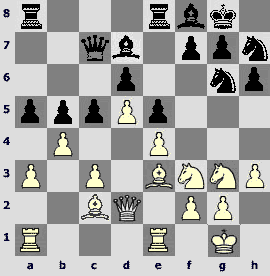
21.¤h5?! Obviously the knight is going the wrong way. Its place is on f5. It was possible to jump there at once or to insert the exchange on c5.
Also interesting is 21.c4!? axb4 (21...bxc4 22.bxc5 dxc5 23.Јc3 leads to White`s clear advantage) 22.axb4 cxb4 (here too 22...bxc4 is bad for the same reason as one move before: 23.bxc5 dxc5 24.Јc3) 23.cxb5 Ґxb5 24.Јxb4. Even though Black has exchanged several pawns he is facing a difficult defence.
21...c4! 22.¦eb1 ¦eb8. Perhaps the main part of the advantage has gone but White ought to continue to play. Ѕ–Ѕ
S.Rublevsky – E.Inarkiev [C45]
In this game, too the tournament favouritres clashed but no blood was shed either.
1.e4 e5 2.¤f3 ¤c6 3.d4 exd4 4.¤xd4 Ґc5 5.¤xc6 Јf6 6.Јf3 Јxf3. It is considered that the ending is slightly better for White. So it`s surprising to see this line employed by Inarkiev who is usually attracted by a more complicated play.
7.gxf3 bxc6 8.Ґe3 Ґxe3 9.fxe3 ¤e7 10.¤c3 d6 11.f4 0–0 12.0–0–0 ўh8 13.Ґc4
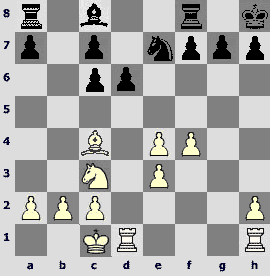
13...Ґb7. I`m curious to know how Sergey would have replied to 13...f5!? I believe the only way to fight for an advantage is a pawn sacrifice 14.e5!? dxe5 15.h4!? (but not 15.fxe5 ¤g6 16.e6 ¦e8 17.¦hf1 ¤e5 18.Ґb3 g6 19.e4 fxe4 20.¤xe4 Ґxe6, and the compensation is insufficient) followed by the typical middle-game advance h4-h5. Needless to say such play in endings is rather risky.
14.Ґb3 ¦ae8. Black has achieved a good set-up. The knight is going to retreat to c8 from where it supports the potential weakness on d6.
15.e5. Making this move Sergey probably said – I can`t wait any longer! It was possible to make an expectant move 15.¦hg1, but here too Black shouldn`t have serious problems.
15...¤c8 16.exd6. A pawn sac 16.¦hg1!? dxe5 17.¦d7 exf4 18.exf4!? ¦e7 19.¦gd1 deserved attention once again.
16...cxd6 17.e4 f5 18.¦he1 fxe4 19.¦xe4 g6 20.¦de1

The ending is still double-edged but the opponents decided not to break a lance. Ѕ–Ѕ
E.Najer – E.Tomashevsky [E20]
1.d4 ¤f6 2.c4 e6 3.¤c3 Ґb4 4.g3 d6 5.Ґg2 ¤bd7 6.¤f3 Ґxc3+ 7.bxc3 0–0 8.0–0 ¦b8 9.¦e1 b6 10.e4 Ґb7 11.Јc2 h6 12.h3 ¦e8

13.g4?! The weakening of the f4 square appears to be significant. Betterwasthestandard13.a4 with an edge.
13...e5 14.g5 hxg5 15.Ґxg5 ¤f8 16.¦ad1 Јe7 17.¤h4 g6 18.¤f3 ¤e6 19.Ґh4 ¤f4 20.¤h2 Ґc8 21.Ґg5 ¤e6 22.Ґh4 ¤f4 23.Ґg5 ¤e6 Ѕ–Ѕ
I.Khairullin – E.Alekseev [B90]
1.e4 c5 2.¤f3 d6 3.d4 cxd4 4.¤xd4 ¤f6 5.¤c3 a6 6.Ґe3 e5 7.¤f3. The fashion is changeable. Not long ago they automatically retreated the knight to b3.
7...Ґe7 8.Ґc4 0–0 9.0–0 ¤c6 10.Јe2 ¤a5 11.Ґb3 h6 12.¦fd1 ¤xb3 13.cxb3. A novelty that didn`t impress me. The traditional 13.axb3 looks a bit stronger.

13...Јe8! A good positional manoeuvre which is well-known however.
14.¤e1 b5 15.¤d3 a5 16.b4 a4 17.¤e1 Ґb7 18.Јxb5 Ґxe4 19.Јxe8 ¦fxe8 20.¤xe4 ¤xe4 21.a3 f5!
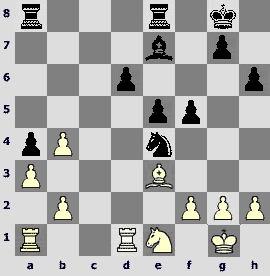
Black has seized the initiative but the young Ildar resisted very tenaciously and saved half a point.
22.¦ac1 ¦ec8 23.¤d3 ўf7 24.f4 ўe6 25.g4 fxg4 26.fxe5 dxe5 27.b5 ¦xc1 28.¦xc1 ¦d8 29.¤b4 Ґg5 30.Ґxg5 ¤xg5 31.ўf2 ¤e4+ 32.ўe3 ¤d6 33.b6 ¦b8 34.¦c6 ўd7 35.¦c7+ ўe6 36.¦c6 ўd7 37.¦c7+ ўe6 38.¦c6 ¦b7 39.¤d3 ¦b8 40.¤b4 Ѕ–Ѕ
N.Vitiugov – D.Khismatullin [E12]
1.d4 ¤f6 2.c4 e6 3.¤f3 b6 4.¤c3 Ґb7 5.a3 d5 6.cxd5 ¤xd5 7.e3 ¤d7 8.Ґd3 ¤5f6 9.e4 c5

10.d5? An unlucky novelty after which an advantage immediately passes to Black. The white pieces don`t arrive at the active positions in time and the d5 pawn loses contact with them turning from a force into a weakness quickly. Correct is 10.Ґf4.
10...exd5 11.exd5 Ґd6 12.0–0 0–0 13.¦e1 a6 14.Ґc2 h6 15.¤h4 Јc7 16.h3. Of course it`s not easy to decide on 16.¤f5 Ґxh2+ 17.ўh1 Ґd6 18.Јf3 (18.¤xd6 Јxd6 19.Јf3) 18...¦fe8 19.Ґd2. White`s compensation isn`t enough but Black could be terrified as the knight on f5 is rather strong.
16...¦fe8 17.Ґe3 ¤e5 18.b3 ¦ad8 19.f4 ¤ed7 20.Јf3 b5 21.¤f5 Ґf8

22.¦ac1? 22.Јg3 which suggests itself isn`t good in view of 22...g6 23.d6 Јc6 24.Ґd1 (24.¤e7+ Ґxe7 25.dxe7 ¦xe7, and White has no compensation for a pawn) 24...b4 25.Ґf3 Јc8, and White should lose a pawn somewhere. Perhaps comparatively better was 22.Ґf2, freeing the e3 square for the knight.
22...g6 23.¤g3 ¤b6 24.f5 g5. The game is decided.
25.¤ge4 ¤fxd5 26.¤xd5 ¤xd5 27.Јf2 c4 28.bxc4 ¤xe3 29.¤f6+ ўh8 30.¤xe8 ¦xe8 31.Ґb3 Јe5 32.cxb5 Ґxa3 33.bxa6 Ґxa6 34.¦c6 Ґb7 35.¦xh6+ ўg7 36.¦b6 Ґa8 37.f6+ ўg6 38.Ґc2+ ўh6 39.¦xe3 Јxe3 40.Јxe3 ¦xe3 41.¦b8 Ґe4 42.¦h8+ ўg6 43.¦e8 Ґxc2 0–1
I.Nepomniachtchi – S.Grigoriants [B11]
1.e4 c6 2.¤c3 d5 3.¤f3 Ґg4 4.h3 Ґxf3 5.Јxf3 e6 6.g3 ¤f6 7.Ґg2 Ґb4 8.0–0 ¤bd7

9.a3! A nice move although is has been known already. 9...Ґxc3 10.Јxc3 dxe4 11.b3 Јe7

12.d3! exd3 13.a4! The exclamation marks are attached rather for the vigour and resoluteness than for the real value of the idea. The pawn is the pawn and I think White`s initiative is suffice to equality at the most which was proved by the following play.
13...0–0 14.Ґa3 c5 15.Јxd3 ¦ab8 16.¦ad1 ¦fd8 17.Јc4 b6 18.Ґb2 ¤f8 19.a5 ¤d5?! The knight begins to rush about. More solid is 19...¦xd1 20.¦xd1 ¦d8 or 19...¤g6.
20.¦fe1 ¤c7 21.Јe4 ¤b5 22.Ґe5 ¦xd1 23.¦xd1 ¦d8 24.¦xd8 Јxd8 25.a6 f6 26.Ґf1 fxe5 27.Ґxb5 Јd5

The position is dynamically balanced. Commonly in such situations one of the opponents gives perpetual which in fact was the case this time.
28.Јh4 ¤g6 29.Јa4 ўf7 30.Ґd3 ¤e7 31.Јh4 ¤f5 32.Јh5+ ўf6 33.g4 e4 34.Ґc4 Јd1+ 35.Ґf1 g5 36.Јe8 ¤d4 37.Јf8+ ўg6 38.Јg8+ ўf6 39.Јf8+ ўg6 40.Јg8+ Ѕ–Ѕ.A nice game!
Round 2
S.Grigoriants – P.Svidler [D81]
1.d4 ¤f6 2.c4 g6 3.¤c3 d5 4.Јb3 dxc4 5.Јxc4 Ґg7 6.e4 0–0 7.Ґe2 ¤a6 8.¤f3 c5 9.d5 e6 10.0–0 exd5 11.exd5 Ґf5 12.Ґe3 Јb6 13.¤h4 Ґd7 14.¦ab1 ¦fe8 15.¦fd1. A simple move which is an improvement nevertheless.
15...¦ac8 16.h3 Јa5 17.¤f3

17...¤b4. The evaluation probably depends on the line 17...b5!? 18.¤xb5 ¦e4 19.Јc3 Јb6 20.¤a3 ¤b4 with active counterplay.
18.¦bc1 b5 19.Јh4 ¤a6 20.a3. Obtaining an advantage Sergey Grigoriants decided to inquire about his opponent`s intentions. Black has no grounds to run the risk therefore a draw was agreed. Ѕ–Ѕ
E.Tomashevsky – S.Rublevsky [A09]
In this game an opening line was played where the sides look at each other from afar. The position never diverged from equality and when nothing has left to play by anymore the opponents signed a peaceful agreement.
1.¤f3 d5 2.c4 dxc4 3.¤a3 a6 4.¤xc4 b5 5.¤e3 Ґb7 6.g3 ¤f6 7.Ґg2 e6 8.a4 ¤bd7 9.axb5 axb5 10.¦xa8 Јxa8 11.Јb3 Јa6 12.0–0 c5 13.Јc3 Ґe7 14.b3 0–0 15.Ґb2 Ґc6 16.¦a1 Јb7 17.¤e5 Ґxg2 18.¤xd7 Јxd7 19.¤xg2 ¦d8 20.d3 Ґf8 21.¤e1 ¤d5 22.Јa5 ¦b8 23.¤f3 f6 24.Јa7 Јxa7 25.¦xa7 c4 Ѕ–Ѕ
D.Khismatullin – D.Jakovenko [B13]
The encounter of two friends was peaceful. All the moves are well-known by theory.
1.c4 c6 2.e4 d5 3.exd5 cxd5 4.d4 ¤f6 5.¤c3 ¤c6 6.¤f3 Ґg4 7.cxd5 ¤xd5 8.Јb3 Ґxf3 9.gxf3 e6 10.Јxb7 ¤xd4 11.Ґb5+ ¤xb5 12.Јc6+ ўe7 13.Јxb5 Јd7 14.Ґg5+ f6 15.¤xd5+ exd5 16.Јxd7+ ўxd7 17.Ґe3 Ґb4+ 18.ўe2 ¦hc8 19.¦hc1 a5 20.¦xc8 ¦xc8 21.¦c1 ¦xc1 22.Ґxc1 a4 Ѕ–Ѕ
E.Alekseev – E.Najer [B80]
1.e4 c5 2.¤f3 d6 3.d4 cxd4 4.¤xd4 ¤f6 5.¤c3 a6 6.g3 e6 7.Ґg2 Ґd7

8.g4! White has carried out g2-g4 in two moves but in return he has avoided the sharp risky Najdorf lines where the early g2-g4 is associated with a piece sacrifice. Besides in this version the black bishop has taken the d7 square which is often assigned to the knight.
8...h6 9.h4 g6?! A dubious decision. Before, 9...¤c6 was seen with a complex play after 10.g5 hxg5 11.hxg5 ¦xh1+ 12.Ґxh1 ¤xd4 13.Јxd4 ¤g4 14.f3 ¤e5 15.f4 ¤c6 16.Јf2.
10.g5 hxg5

11.Ґxg5! The resulting position is of the Keres Attack of the Scheveningen Variation. It isn`t a piece of cake in itself moreover here the serious weakening of the dark squares tells created by the move 9...g6. If only Black could play 11...g6-g7 now this move would have been worthy of consideration. It wouldn`t have solved all the problems however as later on White could have undermined the dark squares by h4-h5-h6! Black`s idea reveals itself in the line 11.hxg5 ¦xh1+ 12.Ґxh1 ¤h5 where he has efficient counterplay.
11...Ґe7 12.Јd2 ¤c6 13.0–0–0 Јb6 14.¤xc6 Ґxc6 15.¦he1! One more good move. The threat of ¤c3-d5 is hanging over Black as the sword of Damocles.
15...¤g8. Played under the tough circumstances.
16.Ґxe7 ¤xe7 17.Јf4 ¦d8 18.Јf6. Simpler was 18.¦xd6, winning a pawn and preserving an active position.
18...¦h5. 18...¦h7 loses to 19.¤d5 Ґxd5 20.exd5 e5 21.¦xe5.

19.¦d2. The rook is placed awkwardly here. It can`t be transferred to the kingside and what is the most important this move loses a vital tempo.
19.¤d5 doesn`t achieve its object – 19...Ґxd5 20.exd5 e5 with an unclear position. It seems to me that stronger is 19.Ґh3! and if 19...Јa5 then 20.f4 (20.e5 ¤d5 21.¤xd5 Ґxd5 isn`t dangerous for Black) and Black can`t play 20...ўf8 in view of 21.Ґxe6.
19...ўf8? 19...Јa5! would force White to be deep in thought: 20.f4 (Јe5 was threatening) 20...ўf8!, and now he had to decide on 21.f5! (otherwise ¤g8 resolves all the problems for example 21.¦ed1 ¤g8 22.Јd4 ¦xh4, to 21.¦h1 Black has a choice between the safe 21...Јb6 and the sharp 21...b5) – White has a strong initiative but Black can grab a pawn somewhere and at least he wouldn`t suffer for nothing.
20.Ґf3 ¤g8 21.Јf4 ¦h6 22.h5! Јc5 23.¦g1 ўe7 24.¦g5 e5 25.Јg3 ¤f6 26.hxg6 ¦xg6 27.¦xg6 fxg6 28.Јxg6 ¦g8 29.Јh6 ¦g1+ 30.Ґd1 ¦g2 31.Јh4 b5 32.Ґf3 ¦g1+ 33.¦d1 ¦xd1+ 34.¤xd1 Јc4 35.¤e3 Јxa2 36.¤f5+ ўe6

37.Јh3. The following computer line is winning: 37.Ґg4 Јa1+ 38.ўd2 Ґxe4 39.¤xd6+ ¤xg4 40.¤xe4 Јg1 41.Јd8 ўf7 42.Јd7+ ўf8 43.Јd6+ ўg7 44.Јxa6 and only the accuracy in realization is required from White. To find it all over the board is possible (as well as the reason for which the text doesn`t win) but not in time trouble of course.
37...Јa1+ 38.ўd2 ¤xe4+? Black shouldn`t have missed this lucky chance –38...Ґxe4! suddenly let him to save the game: 39.¤d4+ ўd5 40.Јe6+ ўxd4 41.Јxf6 Ґxf3 42.Јxd6+ with perpetual.
39.Ґxe4 Ґxe4 40.¤e3+. The rest is simple. 40...ўf7 41.Јd7+ ўf8 42.Јxd6+ ўf7 43.¤g4 Јg1 44.Јf6+ ўg8 45.Јg5+ ўf8 46.Јh6+ ўf7 47.¤xe5+ ўg8 48.Јe6+ ўg7 49.Јf7+ ўh8 50.Јf4 Јg2

51.b4. The most technical way. After the queens exchange the a6 pawn will fall down as a ripe grape.
51...Ґd5 52.ўe3 ўg7 53.Јg4+ Јxg4 54.¤xg4 Ґe6 55.ўf4 ўg6 56.¤e3 ўf6 57.ўe4 Ґf7 58.ўd4 ўe6 59.ўc5 ўe5 60.ўb6 Ґe8 61.ўxa6 ўe4 62.ўb6 ўd4 63.ўa5 Ґd7 64.ўb6 Ґe8 65.¤f5+ ўe5 66.¤e7 ўd4 67.f4 ўc4 68.¤c6 ўd5 69.¤e5 ўd4 70.c3+ ўd5 71.¤f3 ўe4 72.¤d4 ўxf4 73.¤xb5 ўe3 74.¤d6 Ґa4 75.ўc5 1–0. Regardless of some inaccuracies it was a very good game.
E.Inarkiev – N.Vitiugov [B48]
1.e4 c5 2.¤f3 e6 3.¤c3 ¤c6 4.d4 cxd4 5.¤xd4 Јc7 6.Ґe3 ¤f6 7.f4. This sharp thrust was revived by Ernesto in his mini-match against Alexander Khalifman in Khanty-Mansiysk. He succeeded in gaining a big advantage in that game.
7...Ґb4 8.¤db5 Јa5 9.e5 ¤e4 10.Јd3 ¤xc3 11.bxc3 Ґe7 12.g3 0–0. An attempt of improvement. I remember Nikita commented on the afore-mentioned game (where 12...a6 13.¤d6 Ґxd6 14.exd6 b5 15.Ґg2 was played) and suggested an improvement for Black which makes the theoretical discussion even more interesting.
13.Ґg2 f6 14.exf6 Ґxf6 15.0–0 d5 16.¦fe1 Ґd7 17.Ґh3 ¦ac8 18.¦ab1

The opening results are not altogether sad for Black but surely he has no reasons to be glad. His position is passive and he is doomed to defence. The following play wasn`t error free. After a little time scramble fever White managed to score the win.
18...¤e7 19.Ґd2 Јa6 20.¤d4 Ґxd4+ 21.cxd4 ¦c4 22.Ґb4 ¦f7 23.Ґxe7 ¦xe7 24.f5 Јxa2 25.¦xb7 Јa5 26.Јf1 ¦f7 27.Јe2 ¦xc2 28.fxe6 ¦f8 29.Јe3 Ґc8 30.e7 ¦e8 31.¦f1 Јa6 32.¦f8+ 1–0
I.Nepomniachtchi – I.Khairullin [C77]
1.e4 e5 2.¤f3 ¤c6 3.Ґb5 a6 4.Ґa4 ¤f6 5.Јe2. A rare line. 5...Ґe7 6.c3 b5 7.Ґc2 d6 8.d4 exd4 9.¤xd4 Ґb7 10.¤f5 0–0 11.Ґg5 ¤d7

12.h4!? The acute attacking move, extremely committal and risky. Whiteburnsallthebridges.
12...Ґf6 13.¤d2 b4 14.¦h3 ўh8 15.f4 bxc3 16.bxc3 ¤e7 17.¦b1?
As Vadim Zvjaginsev discovered 17.e5! dxe5 18.0–0–0! Would have been a good continuation of an original White`s play.

Here is his analysis: 18...¤d5? 19.fe5! (19.¤g7 ¤f4! 20.Ґf4 Ґg7 21.Ґg5 Јe8!) 19...Ґg5 (19...¤e5 20.¤e4) 20.hg5 ¤f4 21.¦h7 ўh7 22.Јg4 mating or 18...¤g6?! 19.¤e4 (19.fe5!? is not that clear on account of 19...¤ge5) 19...¤f4 (19...Ґg5? 20.hg5 ¤f4 21.¦h7 ўh7 22.¦h1 ўg8 23.Јg4 g6 24.Јh4 ¤h5 25.¤eg3 Ґg2 26.¤h5 Ґh1 27.¤f6 mating) 20.Ґf4 ef4 21.¦hd3 Ґc6 22.¤c5 with an edge. The best is 18...¤f5 19.Ґf5 Јe7 20.¤c4 Ґc6, and Black holds somehow for example 21.fe5 (the ending after 21.Ґf6 ¤f6 22.Јe5 doesn`t give White an advantage) 21...g6! 22.Јe3 Ґg5 23.hg5 ¦fd8! 24.¦dh1 ¤f8.
17...Ґc6

The white king remained in the centre. This position should already be evaluated as favourable for Black.
18.Ґxf6 ¤xf6 19.¤d4 Ґd7 20.e5 ¤fd5 21.¦h1 ¤xf4 22.Јe4 ¤eg6 23.h5 dxe5 24.hxg6 fxg6 25.¤c6 Ґxc6 26.Јxc6 Јg5 27.Ґe4 ¦ad8 28.¦b2 ¦d6 29.Јxc7 ¦fd8 30.¤f1 ¤e6 31.Јb8 ¦d1+ 32.ўf2 Јf4+ 33.Ґf3 ¦xb8 34.¦xb8+ ¦d8 35.¦xd8+ ¤xd8 36.¤g3 h6 37.¤e4 ¤e6 38.¦e1 ўh7 39.g3 Јf8 40.¦e2 Јc8 41.Ґg4 Јc4 42.Ґxe6 Јxe6 43.ўe3 a5 44.¦d2 a4 45.¤d6 Јh3 46.¤e4 Јf1 47.¦e2 g5 48.c4 Јc1+ 49.ўd3 Јd1+ 50.¤d2 Јg1 51.¦e3 Јa1 52.¦e2 Јxa2 53.¦xe5 Јa3+ 54.ўc2 Јxg3 55.¦e6 Јf2 56.¦e5 g4 57.c5 Јd4 58.¦f5 ўg6 0–1
Round3
D.Jakovenko – E.Inarkiev [C84]
The King`s Indian is not an easy opening but Ernesto is ready to play even the inferior version of it that arises after 1.e2-e4! Nevertheless his opening experiment didn`t justified itself.
1.e4 e5 2.¤f3 ¤c6 3.Ґb5 a6 4.Ґa4 ¤f6 5.0–0 Ґe7 6.d3 d6 7.c3 0–0 8.¦e1 ¦e8 9.d4 Ґd7 10.d5 ¤b8 11.Ґxd7 ¤bxd7 12.c4 g6 13.¤c3 ¤h5 14.¦b1 ¤g7 15.b4 b6 16.a4 a5 17.bxa5 ¦xa5 18.¤d2 ¤c5 19.Ґa3 ¤b7 20.Ґb4 ¦a7 21.¦a1 Јd7 22.¤b3 ¦ea8 23.Јd2 f5 24.f4 Ґf6 25.exf5 gxf5 26.fxe5 dxe5 27.¦f1 ¤d6 28.c5 bxc5 29.¤xc5 Јf7 30.a5 ¦b8 31.¦ab1 e4 32.a6 Јe7

33.¤5xe4! A simple but all the same a nice blow. The rest is just a technique.
33...¦ba8 34.¤c5 Ґg5 35.¦fe1 Ґxd2 36.¦xe7 ¦b8 37.Ґa3 ¦xb1+ 38.¤xb1 Ґa5 39.ўf1 ¤ge8 40.ўe2 Ґb6 41.¤c3 ¤f6 42.¤e6 ¤fe8 43.¤a4 ¦xa6 44.Ґxd6 ¤xd6 45.¤xb6 ¦xb6 46.¦g7+ ўh8 47.¦xc7 h6 48.ўf3 ¦b2 49.ўf4 ¦e2 50.h3 ўg8 51.¦g7+ ўh8 52.¦g6 ¦e4+ 53.ўg3 ¦e3+ 54.ўh4 ¤f7 55.¦f6 ўg8 56.¦xf5 ¦d3 57.¤f4 ¦e3 58.g4 ўg7 59.¤h5+ ўg8 60.¦f6 ўf8 61.¤g3 ўg7 62.¤f5+ ўxf6 63.¤xe3 ¤g5 64.d6 1–0
P.Svidler – D.Khismatullin [B90]
1.e4 c5 2.¤f3 d6 3.d4 cxd4 4.¤xd4 ¤f6 5.¤c3 a6 6.Ґe3 e5 7.¤b3 Ґe6 8.Јd2 ¤bd7 9.f4 Јc7 10.0–0–0 b5 11.ўb1 ¦c8 12.h3 h5 13.Ґd3 Ґe7 14.¦he1 ¤b6 15.Ґxb6 Јxb6 16.¤d5 Јb7 17.¤a5 Јa7 18.¤xe7 Јxe7 19.f5 Ґd7

20.c4. In the Najdorf with opposite sides castling White often develops the queenside initiative. Precisely this plan is implemented by Peter Svidler in the present game. The alternative is 20.g3 preventing the blockade after h5-h4 and preparing the following advance g3-g4. It doesn`t look bad either.
20...h4 21.cxb5 axb5 22.Ґc2 0–0 23.Јxd6 Јd8

24.b4! Јc7 25.Јxc7 ¦xc7 26.Ґd3 ¦fc8 27.¦c1 ўf8 28.¦xc7 ¦xc7 29.¤b3 ўe7 30.¤d2 ¤h5 31.¤f3 ўf6 32.¤xh4 ўg5 33.¤f3+ ўf4 34.ўb2 f6 35.¤d2 ўg3 36.¦e2 Ґc6 37.¤f1+ ўh4 38.¦e3 ¦d7 39.¤d2 ¦d6 40.¤f3+ ўg3 41.¤xe5+ ўf4 42.¤g4 1–0.A good and clear game very typical of Peter Svidler.
I.Khairullin – S.Grigoriants [B12]
1.e4 c6 2.d4 d5 3.e5 Ґf5 4.¤f3 e6 5.Ґe2 ¤e7 6.0–0 ¤g6. The knight and the bishop are good-looking but the bishop f5 has no squares to retreat therefore it is vulnerable.
7.Ґe3 ¤d7. To the consistent 7...f6 even 8.¤e1 is strong creating the threat of g2-g4.
8.¤e1 h5 9.c3 Јb6 10.b3 h4 11.¤d3 c5 12.dxc5 Јc7 13.b4 ¤gxe5. The interposition of 13...h3 (with idea to exploit the weakening of the king`s position after g2-g3) runs into 14.g4! Ґxd3 15.Ґxd3 ¤gxe5 16.Ґe2and White has better prospects.
14.¤xe5 Јxe5. Also possible is 14...¤xe5 15.¤a3 a6 with a complex fight where White`s chances are slightly better.

15.Ґd4. The position is very rich of possibilities. Interesting is both 15.¤d2 and 15.¤a3.
15...Јc7 16.c4 dxc4 17.Ґxc4 h3 18.g3 Јc6 19.f3
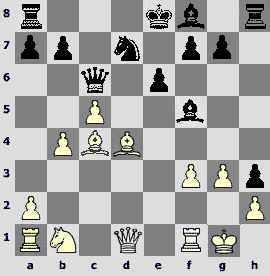
And here a draw was suddenly agreed.Ѕ–Ѕ
From the computer standpoint the following line is virtually forced: 19...a5 20.¤c3 axb4 21.Ґb5 Јc7 22.¤a4 ¦a5 23.Јe2 Ґc2 24.¤b6 Ґxc5 25.Ґxd7+ ўd8 26.Ґxc5 Јxc5+ 27.Јf2 (Black doesn`t run the risk after 27.ўh1 Јxb6 28.Ґxe6 Јxe6 29.Јxc2 ¦hh5!) 27...Јxf2+ 28.¦xf2 b3 29.¤a4 b5 30.axb3 Ґxb3 31.Ґxb5 ¦xb5 32.¤c3 ¦c5 33.¦d2+ Ґd5 34.¤xd5 exd5 35.¦a8+ ¦c8 36.¦a7

To defend the rook ending isn`t an easy task for Black despite the extra pawn. But the defence exists nevertheless: 36...ўe8! 37.¦e2+ (37.¦xd5 ¦h6!) 37...ўd8! (37...ўf8 38.¦ee7), and in case of 38.¦xf7 Black has 38...¦c1+ 39.ўf2 ¦h1!, and it is already White who should search for salvation.
S.Rublevsky – E.Alekseev [В30]
1.e4 c5 2.¤c3 ¤c6 3.¤f3 ¤f6 4.Ґb5 Јc7 5.0–0 ¤d4 6.d3 a6 7.Ґa4 b5. I like 7...¤g4 more, provoking g2-g3.
8.Ґb3 ¤xb3 9.axb3 Ґb7 10.Ґg5 e6 11.¦e1 d6 12.Ґxf6 gxf6 13.d4 cxd4 14.¤xd4. When I see this structure a game comes to mind where Vasily Ivanchuk once beat Garry Kasparov. In that game Vasily showed the knights` mobility in the similar pawn structure.
14...Јc5 15.Јd3 Ґe7
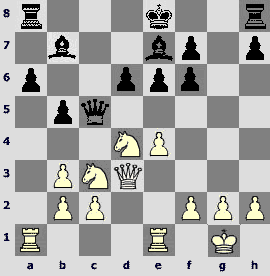
16.b4!! Јg5?! Black doesn`t dare to accept the challenge: 16...Јxb4 17.¤d5! exd5 (in the ending after 17...Јc4 18.Јxc4 bxc4 19.¤c7+ ўd7 20.¤xa8 ¦xa8 Black will suffer though his drawing chances are good) 18.exd5 ¦c8! [the strongest; inferior is 18...Ґxd5 19.Јe3 (19.¦xe7+ ўxe7 20.¤f5+ ўf8 21.Јxd5 ¦e8 favours Black) 19...Ґe6 20.¤xe6 fxe6 21.Јxe6 d5 22.Јc6+ ўf7 23.Јxd5+ ўg7 24.¦e4 ¦hd8 25.Јe6 Јxb2 26.Јxe7+ ўh8 27.¦ae1 and White has a clear advantage thanks to a better protected king] 19.¤f5 ¦c7 20.¦e4 Јc5 21.¦ae1 Јxd5 22.¦xe7+ ўd8 23.Јxd5 Ґxd5 24.¦7e2 ¦d7. In this ending Black has good drawing as the direct play doesn`t work: 25.¦d2 Ґe6 26.¤d4 ¦e8 27.¦a1 Ґd5, and Black parries the threats. More dangerous is the wily 25.¦e3, retaining all the threats of attacking the weal black pawns.
17.¦e3. The rook along the third rank perfectly guards the kingside.
17...ўf8?! Black ought to dare to play 17...f5. At least because now he is left without counterplay.
18.¦g3 Јh6 19.¤b3! Black is unable to protect his queenside.
19...¦d8 20.Јd4 d5 21.Јa7 Ґa8 22.Јxa6 (23.Јxa8 is threatening) 22...¦g8 23.exd5 Ґxd5 24.¤xd5 ¦xg3? 24...¦xd5 still allowed to offer resistance.

25.¤xe7! ¦g5 26.Јb7 Јh3 27.¤c5 ўg7 28.g3 ¦h5 29.Јg2 Јg4 30.¤d3 Јc4 31.Јf3 1–0. So far this game is the best in the tournament.
E.Najer – I.Nepomniachtchi [D30]
1.¤f3 d5 2.d4 c6 3.c4 e6 4.e3 ¤f6 5.Ґd3 ¤bd7 6.b3 Ґd6 7.Ґb2 0–0 8.¤bd2 b6 9.0–0 Ґb7 10.Јe2 Јe7 11.e4 dxe4 12.¤xe4 ¤xe4 13.Јxe4 f5 14.Јe3 c5 15.¦fe1 ¦ae8 16.¤g5 e5 17.d5 e4 18.Ґf1 ¤e5 19.f4 exf3 20.¤xf3 ¤xf3+ 21.Јxf3 Јxe1 22.¦xe1 ¦xe1 23.Ґc3 ¦e7 24.Ґd2 f4 25.Ґd3 g6 26.h3 Ґc8 27.Ґc2 ¦ff7 28.Ґd3.

The young Ian Nepomniachtchi did his best in this game. In the opening he displayed a knowledge better than Evgeny Najer`s one and as a result obtained an advantage. In the diagrammed position he fulfils a plan of which even Tigran Vartanovich Petrosian woudn`t be ashamed. The black king is sent towards the safe place on c7 or b7 where he will be protected from checks.
28...ўf8 29.a3 a5 30.Јf1 ўe8 31.Ґe2 ўd8 32.Ґg4 Ґxg4 33.hxg4 ¦e4 34.Јf3 ¦fe7 35.g5 ўc7 36.Јg4 ¦d4 37.Ґc3 ¦d3 38.Ґf6 ¦g3 39.Јh4 ¦d7 40.ўf1 b5 41.cxb5 ўb6 42.a4 ўb7 43.ўf2 Ґc7 44.Јh1 ¦xb3 45.Јd1 ¦e3 46.ўf1 c4 47.ўg1 c3 48.Јb3 Ґb6 49.ўh2 f3 50.gxf3 ¦xf3 51.Јc4 ¦c7 52.Јe4 ¦e3 53.Јg2 c2 54.d6+ ўa7 55.d7 ¦c4 0–1. An excellent game!
N.Vitiugov – E.Tomashevsky [E13]
1.d4 ¤f6 2.c4 e6 3.¤f3 b6 4.¤c3 Ґb4 5.Ґg5 Ґb7 6.¤d2. It`s time to discard this new-fangled move.
6...h6 7.Ґh4 ¤c6 8.e3 ¤e7! This manoeuvre is already known and it`s unclear what Nikita counted on in the opening.
9.Ґxf6 gxf6 10.Јb3 c5 11.d5 f5 12.0–0–0 ¤g6 13.a3 Ґxc3 14.Јxc3 Јc7 15.Ґd3. The position is about equal and taking into account the way Nikita had started the tournament he wanted to take a break. The offer was accepted with understanding and the first draw in the round has been registered.Ѕ–Ѕ
